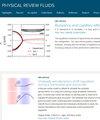Heat transport in three-layer turbulent thermal convection
IF 2.5
3区 物理与天体物理
Q2 PHYSICS, FLUIDS & PLASMAS
引用次数: 0
Abstract
We report an experimental study of heat transport in a three-layer turbulent Rayleigh-Bénard convection. The experiments were conducted in a cylindrical cell (with diameter ) filled with a FC77 layer with height . A very thin layer of water and a very thin layer of mercury were introduced to the top and bottom of the FC77 layer to provide slippery boundary conditions. We performed high spatial resolution temperature measurements across the water-FC77 and FC77-mercury interfaces, determined the temperatures at the two interfaces, the Rayleigh number (Ra) and the Nusselt number (Nu) across the FC77 layer. The experiments were conducted in the Ra range of to for the FC77 layer. It is found that not only the amplitude but also the scaling exponent (with Ra) of Nu is greatly enhanced in this three-layer system compared to the canonical single-layer system, especially in the high Ra range. In particular, first scales as and then when Ra exceeds a transitional Rayleigh number , whereas in the canonical single-layer FC77 case, is found to scale as . Temperature measurements show that the boundary condition above and below the FC77 layer is asymmetric especially when : the temperature drop across the top half (in contact with the water layer) of the FC77 layer is smaller than that across the bottom half (in contact with the mercury layer), and the top thermal boundary layer (TBL) becomes thinner and follows a steeper scaling with compared to the bottom TBL. We consider a hypothetical experiment where the top and the bottom boundary conditions are symmetric, denoted as a “water-FC77-water” three-layer system, in which the temperature drop across the bottom boundary layer would be the same as that across the top boundary layer . We found in this water-FC77-water three-layer system, with the increase of Ra, vs scaling transitions from to with the transitional Ra the same as identified before. A closer check of the evolution of Ra of the water layer, FC77 layer, and the mercury layer reveal that the transition of the vs scaling is due to the transition of the thin water layer from a conduction state to a convection state, whereas the mercury layer remains in a conduction state.

三层湍流热对流中的热传输
我们报告了对三层湍流雷利-贝纳德对流中热量传输的实验研究。实验在一个充满 FC77 层(高度为 H=D)的圆柱形单元(直径为 D)中进行。在 FC77 层的顶部和底部分别引入了极薄的水层和极薄的汞层,以提供滑动边界条件。我们在水-FC77 和 FC77-汞界面上进行了高空间分辨率温度测量,确定了两个界面上的温度、FC77 层上的雷利数(Ra)和努塞尔特数(Nu)。实验在 FC77 层的 Ra 范围 2.81×109 至 1.24×1011 之间进行。实验发现,与典型的单层系统相比,在这种三层系统中,Nu 的振幅和缩放指数(随 Ra 变化)都大大增强,尤其是在高 Ra 范围内。特别是,当 Ra 超过过渡瑞利数 Rat=2.52×1010 时,Nu 首先按 Ra0.31 的比例缩放,然后按 Ra0.38 的比例缩放,而在典型的单层 FC77 情况下,Nu 按 Ra0.26 的比例缩放。温度测量结果表明,FC77 层上下的边界条件是不对称的,尤其是当 Ra>Rat 时:FC77 层上半层(与水层接触)的温降小于下半层(与水银层接触)的温降,而且顶部热边界层(TBL)变得更薄,与底部 TBL 相比,随 Ra 变化的比例更陡峭。我们考虑了一个顶部和底部边界条件对称的假设实验,称为 "水-FC77-水 "三层系统,其中底部边界层的温降 ΔTb 与顶部边界层的温降 ΔTt 相同。我们发现,在这个水-FC77-水三层体系中,随着 Ra 的增加,Nu 与 Ra 的比例关系从 Nu∼Ra0.31 过渡到 Nu∼Ra0.46,过渡期间的 Ra 与之前确定的 Rat 相同。仔细观察水层、FC77 层和汞层的 Ra 演变,可以发现 Nu vs Ra 缩放的过渡是由于薄水层从传导状态过渡到对流状态,而汞层仍然处于传导状态。
本文章由计算机程序翻译,如有差异,请以英文原文为准。
求助全文
约1分钟内获得全文
求助全文
来源期刊

Physical Review Fluids
Chemical Engineering-Fluid Flow and Transfer Processes
CiteScore
5.10
自引率
11.10%
发文量
488
期刊介绍:
Physical Review Fluids is APS’s newest online-only journal dedicated to publishing innovative research that will significantly advance the fundamental understanding of fluid dynamics. Physical Review Fluids expands the scope of the APS journals to include additional areas of fluid dynamics research, complements the existing Physical Review collection, and maintains the same quality and reputation that authors and subscribers expect from APS. The journal is published with the endorsement of the APS Division of Fluid Dynamics.
 求助内容:
求助内容: 应助结果提醒方式:
应助结果提醒方式:


